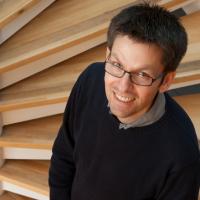
Agroecology Reading time 6 min
Olivier Hamant, shaping up
Published on 29 November 2012 (date.last_update 27 November 2020)
Olivier Hamant’s hobbies include free jazz, contemporary art, science and cortical microtubules. Curious by nature, Olivier likes to connect the dots. “Research is like contemporary art: a way to ask questions. I love looking for answers in science and approaching a problem from all angles. As a team we try to think outside the box by inversing postulates to go that extra mile. My research on microtubules sometimes follows me home at night and on the weekend,” admits Olivier, who tries to conduct his feverish microtubular guesswork within a ‘reasonable’ work schedule.
How plants get their shape
He completed his PhD in 2002 at INRA Versailles and at the VIB in Flanders, Belgium, on the molecular aspects of plant architecture, notably showing how the gaseous hormone ethylene regulates the activity of developmental master genes. He completed post-doctoral work in the United States at the University of California at Berkeley on a completely different subject: meiosis in corn. He identified and characterised two proteins which control chromosome segregation and, by extension, heredity. Olivier began working at INRA in 2007 in the Plant Development and Reproduction Laboratory at the ENS in Lyon. His work juggles physics, biology and imaging. As he puts it: “our work equates ideas and tests hypotheses. My focus is on mechanical feedback: when a plant grows, so do its cells, which must grapple with certain mechanical forces. What role do these forces play? Do cells use these forces to control shape changes? This type of basic research seems highly abstract at first glance, but is a key ingredient in predictive biology and plant breeding!”
A regular cell mechanic
Olivier Hamant has written over twenty scientific papers in the last ten years, including an article published in Science in 2008 for which he was lead author. “The approach taken in this paper was very well received by the scientific community. As a result, I was asked to write several reviews on topics which straddle physics and molecular biology.” His latest paper, published in Cell this year, highlights the synergy between cellular heterogeneity and mechanical forces and how this affects tissue growth, with potential extensions and applications beyond the realm of plants. Olivier’s interests also stretch to several realms: he enjoys writing about science for the general press, he teaches introductory biology to physicists and introductory modelling to biologists, and in his spare time composes music for his jazz band.
Dr Hamant also oversees international projects, including a French/Polish project on cellular heterogeneity in morphogenesis and an ANR project on the impact of a tissue’s mechanical properties. He has also set up partnerships between European and American scientists with the aim of further integrating biophysics and cell biology.

- 38 years old
- Preparatory classes in biology; Masters 1 in Earth Life Sciences at the Ecole Normale Supérieure in Lyon; Masters 2 at the Université Pierre et Marie Curie;
- PhD at INRA Versailles under the supervision of Véronique Pautot;
- Postdoctoral fellowship at VIB in Ghent (6-month Marie Curie Fellowship); postdoctoral fellowship at the University of California, Berkeley (3 years); postdoctoral fellowship then tenured position at INRA at the ENS in Lyon (Plant Reproduction and Development Laboratory - Jan Traas)
- Winner of INRA's Young Researcher Award in 2012
- Recipient of a ERC Consolidator Grant in 2013
- Winner of the Prix Foulon of the French Académie des Sciences on 24 November 2020
- Distinctive feature: interdisciplinary research on plants (biology/physics/modelling)
- Loves jazz and contemporary art
